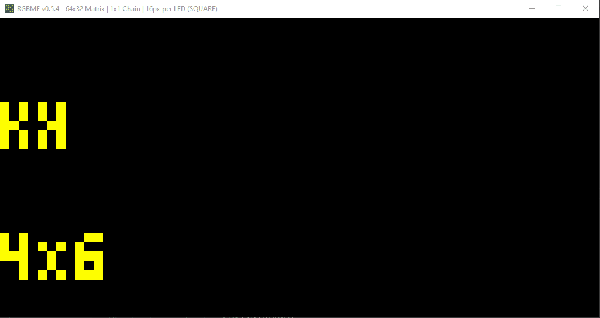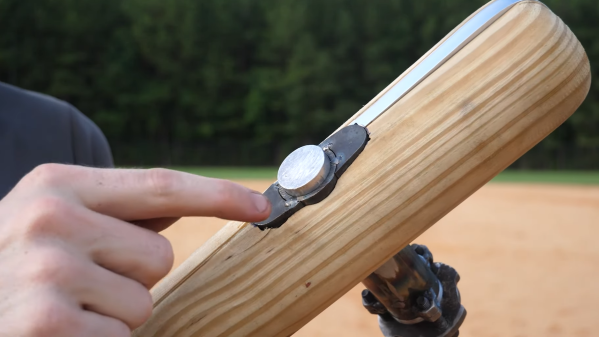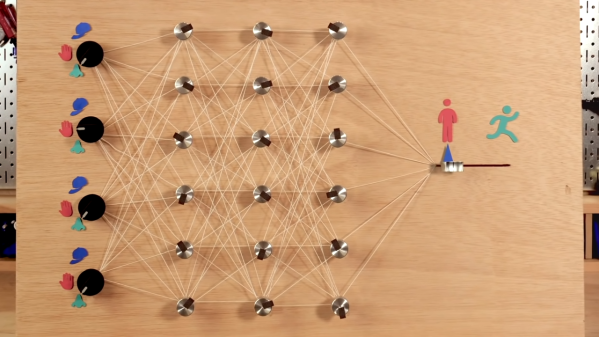When monitors around the world display a “Blue Screen of Death” and you know it’s probably your fault, it’s got to be a terrible, horrible, no good, very bad day at work. That’s likely the situation inside CrowdStrike this weekend, as engineers at the cybersecurity provider struggle to recover from an update rollout that went very, very badly indeed. The rollout, which affected enterprise-level Windows 10 and 11 hosts running their flagship Falcon Sensor product, resulted in machines going into a boot loop or just dropping into restore mode, leaving hapless millions to stare at the dreaded BSOD screen on everything from POS terminals to transit ticketing systems.
baseball8 Articles
Modifying Old Fonts In The Name Of Baseball
Baseball is in full swing again, and having recently accepted a position with Major League Baseball, [Ty Porter] is warming up with a big contribution to the MLB LED Scoreboard project — modifying 20-some old fonts to support baseball’s ‘ꓘ’ character that indicates a special strikeout with a called third strike (meaning the batter didn’t take a swing).
The problem is that Major League Baseball-the-entity recently deprecated the original data source for the scoreboard project. This called for a huge refactor of the codebase, including previously-patched fonts which were now showing either the font’s default no-character character, or nothing at all.
Fortunately, BDF font files are fairly human-readable and make reference to bitmap, which is an actual bitmap in hex. [Ty] settled on Unicode A4D8 (ꓘ), a character from the Tibeto-Burman language Lisu that certainly looks good enough to this baseball fan. Then it became a matter of mirroring the bitmap for ‘K’. [Ty] tried a few things like reversing the nibbles and looking up each one in a table, but that also mirrors the padding, which is bad news.
Then he tried not reversing the nibbles and just looked them up in a table, but this approach dropped and added bits unintentionally. Finally, he tried reversing the order, looking up the reversed nibble, and shifting each byte until there was no padding. This worked for most of the 20 fonts [Ty] patched. The others fell in line with some manual work.
Not much of a baseball fan? You’re almost guaranteed to like this one, especially if you hate mayo.
Supersonic Baseball Hitting A Gallon Of Mayo Is Great Flow Visualization
Those of us who enjoy seeing mechanical carnage have been blessed by the rise of video sharing services and high speed cameras. Oftentimes, these slow motion videos are heavy on destruction and light on science. However, this video from [Smarter Every Day] is worth watching, purely for the fluid mechanics at play when a supersonic baseball hits a 1-gallon jar of mayo.
The experiment uses the baseball cannon that [Destin] of [Smarter Every Day] built last year. Ostensibly, the broader aim of the video is to characterize the baseball cannon’s performance. Shots are fired with varying pressures applied to the air tank and vacuum levels applied to the barrel, and the data charted.
However, the real glory starts 18:25 into the video, where a baseball is fired into the gigantic jar of mayo. The jar is vaporized in an instant from the sheer power of the collision, with the mayo becoming a potent-smelling aerosol in a flash.
Amazingly, the slow-motion camera reveals all manner of interesting phenomena. There’s a flash of flame as the ball hits the jar, suggesting compression ignition happened at impact with the jar’s label. A shadow from the shockwave ahead of the ball can be seen in the video, and particles in the cloud of mayo can be seen changing direction as the trailing shock catches up.
The slow-motion footage deserves to be shown in flow-visualization classes, not only because it’s awesome, but because it’s a great demonstration of supersonic flow phenomena. Video after the break.
Continue reading “Supersonic Baseball Hitting A Gallon Of Mayo Is Great Flow Visualization”
Going For The Home Run Record With Explosive Help
The baseball home run distance challenge for crazy engineers is really heating up, with the two main (only?) competitors joining forces. [Shane] of [Stuff Made Here] and [Destin] of [Smarter Every Day] did a deep dive into [Shane]’s latest powder charged baseball bat, designed to hit a ball 600+ feet.
[Shane] built two new versions of his bat this time, using the lessons he learned from his previous V1 and V2 explosive bats. It still uses blank cartridges, but this time the max capacity was increased from three to four cartridges. For V3 a section of the bat was removed, and replaced with a four-bar linkage, which allowed the entire front of the bat to move. The linkage integrated a chamber for four blank cartridges that could be loaded almost like a double barrel shotgun and closed with a satisfying snap. Unfortunately the mass of the moving section was too much for the welds, and the entire front broke off on the first test, so the design was scrapped.
V4 returned to the piston concept of the initial version, except V4 contains two parallel pistons, in a metal bat, with a larger hitting surface. With two cartridges it worked well, but parts started breaking with three and four, and required multiple design updates to fix. [Destin] covered the physics of the project and took some really cool high speed video. He and [Jeremy Fielding] hold the current distance record of 617 ft with their crazy Mad Batter. Unfortunately on [Shane]’s final distance attempt the bat broke again, and the ball was lost in a field with tall grass beyond the 600-foot mark, so they could not confirm if the record was actually broken.
[Destin] and his team still remain the undisputed baseball velocity record holders, with their supersonic baseball canon. It sounds like there might be another collaboration between [Destin] and [Shane] in the future, and we’re definitely looking forward to the results of that crazy venture. Continue reading “Going For The Home Run Record With Explosive Help”
A Special Baseball Bat With Explosive Hitting Power
To make up for some lacking athletic ability, [Shane Wighton] of [Stuff Made Here] created a custom baseball bat with an explosive sweet spot, that almost guarantees a home run. Inside a custom machined bat, he added a piston mechanism, powered by blank cartridges intended for powder actuated nailers, that can hit a ball with impressive force.
Up to three rimfire blank cartridges are placed in the stationary side of the piston mechanism, and are fired by three firing pins on the back of the piston when a ball hits the front of the piston. The expanding gasses then drive the piston out at high velocity, hitting the ball, before it is stopped from flying out completely by a crossbar. The gasses are exhausted through the side of the sleeve, into a “muffler” machined into the front of the bat. The first time [Shane] fired the mechanism with two cartridges, it almost sheared off the stopping bar, and damaged all the other components and blew the bat apart. This led to a complete redesign, including a crossbar with urethane dampers and an aluminum muffler.
The results with the “upgrades” are pretty impressive, and a little scary. Batting distance was around 350 feet with two cartridges, hitting the ball off a tee to avoid putting a pitcher in the firing line. [Shane] did a lab test with three cartridges, which put a hole in the ball and looked like it would break the bat. He expects that three cartridges would allow him to break the home run record, but would require another redesign and will be left for a future video
We admit to being rather envious of [Shane]’s workshop, and the projects that come out of it. We’ve seen him create an all-in-one golf club, a robotic barber, and a robotic basketball hoop, to name a few.
SoftBank Robots Pinch Hit For Baseball Cheerleaders
Grand venues of spectacle to entertain audiences has long been a part of history, but such tradition is highly problematic at the moment in the light of the pandemic. Some sports leagues are testing the waters with a soft restart by playing only to a broadcast audience, leaving the stadium empty. Many experiments are in progress trying to liven up an empty stadium and this is where SoftBank saw an opportunity: as a multinational conglomerate that has both a baseball team and a robotics division, they called a team of robots to cheer-leading duty.
Some clips of the cheerleading squad in action have started circulating. A few people may greet the sight with an indifferent shrug, but most tend to fall to an extreme: either finding them hilarious or react with horror. It is only natural to have a strong reaction to such a jarring sight.
「Spotさん」と「Pepperさん」によるおそらく宇宙史上初のいざゆけ若鷹軍団コラボレーションダンス(部) #sbhawks pic.twitter.com/MeGxUkmxo6
— パ・リーグ.com Lite / パーソル パ・リーグTV Lite (@PLcom_lite) July 7, 2020
Spot was only available for sale recently, and we admit this was not the type of task that came to our minds. Pepper has a longer track record and this is not Pepper’s first baseball game. The humanoid robot has been around long enough to raise questions about a robot’s role in society from unionization to sex work. We haven’t made much progress answering those questions, and now we have even more questions that the lightweight SoftBank Robotics press release (in Japanese) didn’t try to answer.
When people fret about “robots taking our jobs” the conversation doesn’t usually involve sports team cheerleaders, yet here we are. Welcome to the future.
Continue reading “SoftBank Robots Pinch Hit For Baseball Cheerleaders”
AI Phone App Learns Baseball Signals
Watching a sport can be a bit odd if you aren’t familiar with it. Most Americans, for example, would think a cricket match looked funny because they don’t know the rules. If you were not familiar with baseball, you might wonder why one of the coaches was waving his hands around, touching his nose, his ears, and his hat seemingly at random. Those in the know however understand that this is a secret signal to the player. The coach might be telling the player to steal a base or bunt. The other team tries to decode the signals, but if you don’t know the code that is notoriously difficult. Unless you have the machine learning phone app you can see in the video below.
If you are not a baseball fan, it works like this. The coach will do a number of things. Perhaps touch his cap, then his nose, brush his left forearm, and touch his lips. However, the code is often as simple as knowing one attention signal and one action signal. For example, the coach might tell you that if they touch their nose and then their lips, you should steal. Touching their nose and then their ear is a bunt. Touching their nose and then the bill of their cap is something else. Anything they do that doesn’t start with touching their nose means nothing at all. If the signal is this easy, you really don’t even need machine learning to decode it. But if it were more complicated — say, the gesture that occurs third after they touch their nose unless they also kick dirt at which point it means nothing — it would be much harder for a human to figure out.
















